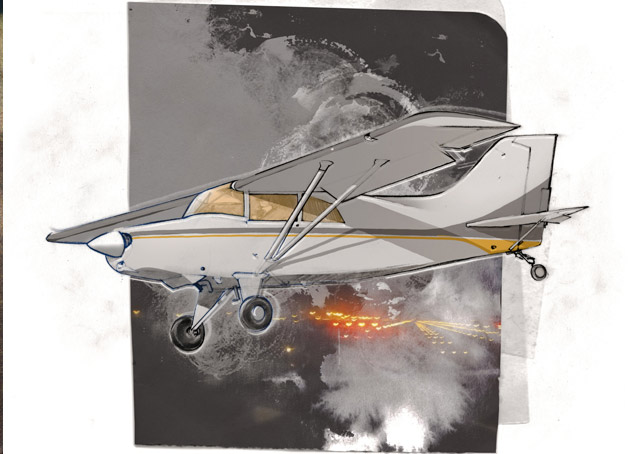 A surprise blackout causes vertigo
A surprise blackout causes vertigo
After a day in Seattle, I looked forward to the flight home with cheerful anticipation. Liftoff from Boeing Field/King County International Airport (BFI) toward Skagit Regional Airport (BVS) occurred as dusk faded. Climbing out over Elliott Bay, I left downtown skyscrapers and the Space Needle behind. A veil of thin cirrus obscured the stars, but a carpet of lights twinkled below as I leveled off for the familiar 45-minute flight north.
“Maule Three-One-One-Eight-Charlie, Paine Tower. Company heavy on six-mile final One Six. Transition approved west of the field.” From 2,800 feet, and out over the water, halogen halos lit Boeing’s huge assembly plant, its packed parking lots witness to 747 and Dreamliner production lines in full swing.
Clearing Paine’s Class D, I hailed Whidbey Approach and picked up my squawk to transit the naval air station’s Class C hornet’s nest. Ten miles south of Skagit, “Maule One-Eight-Charlie, Whidbey Approach. Radar services terminated, squawk VFR, frequency change approved,” filled my headset.
Replying, “One-Eight-Charlie squawk VFR. Goodnight and thanks for your help,” I flopped over to the Skagit CTAF. An aircraft reported left base, intending a stop and go on Runway 29. I radioed, “Skagit Traffic, Maule One-Eight-Charlie, eight miles south, inbound for a 45 entry, left traffic Two Niner. Skagit traffic.”
Flying their crosswind, the aircraft reported visual on me. In a brief sidebar, and with palpable excitement in her voice, the pilot mentioned she was a newly minted private out of Arlington on her first celebratory night mission.
During my downwind, she called her departure to the south. Below, lights outlined familiar Skagit runways as I completed my prelanding checklist, heard “wind calm” on the AWOS, turned base, and replied, “Good flight, pilot. Congratulations. One-Eight-Charlie.”
Turning final at my home airport produced a comfortable thrill. The air felt solid and still. Pitch-dark night absorbed light like a sponge, save for Runway 29’s welcome path. Electing a three-point on the runway aim points, I pulled full flaps. Stabilized and trimmed at 50 knots over the threshold, my Maule was configured for a textbook touchdown. Twelve feet, 10 feet, straddling the centerline…. Blackout!
The mile-long Runway 29’s aim points are the standard 1,000 feet from the threshold. I saw 4,000 feet of runway lights extinguish. The telescopic visual illusion produced by that perspective “V” induced a vertigo swoon. Phantom images swirled. Together, these effects produced a reflexive, mentally uncommanded pull on the yoke as night blindness swallowed visual reference.
Landing in the backcountry, I don’t normally add much nose-up trim and rarely pull full flaps, preferring to eliminate these adverse factors from any go-around. Almost home and in my comfort zone, this familiar approach was stabilized with full flaps and all necessary nose-up trim.
My trained-in response produced twin pushes: yoke and throttle. Too late. That jerk on the yoke deep in the backside of the power curve, application of full power coupled to significant nose-up trim, and a three-point landing attitude all compounded into too many contrary conditions to sustain flight.
The tailwheel hit first as the wings let go. Leverage smacked the mains onto the runway with a spine-shuddering jolt. The Maule bounced into the darkness, pitched up with what my disoriented senses reported as a sheer vertical leap. Under the influence of full flaps, full power, and full nose-up trim, forward push required enormous force.
One or two times a month, I practice go-arounds, stalls, and canyon turns, often adding in a short/steep approach following a short-and-soft-field takeoff—all useful tools to safely fly the often-challenging geography of the Pacific Northwest. I’m not instrument rated, but I also train for inadvertent flight into IMC. That night, while not meteorological, conditions qualified as “inadvertent” and “instrument.”
Under my self-induced “hood,” this “go-around for real” proceeded as practiced: stabilize pitch, maintain runway heading, establish a positive rate of climb, clean up flaps, and trim. After a straight-out, VY climb to 1,500 feet, I turned out north over the farm fields of the Skagit Delta. The flashlight came out of the door pocket for an inspection of gear and wings. What was in view looked OK, and flight controls felt positive and smooth.
After a few minutes level at 1,500 feet sorting out self and aircraft, body, eyes, and airplane seemed enough in order to reverse course. Crossing midfield to enter the downwind, seven CTAF clicks illuminated Runway 29’s lights, and the ensuing landing featured an uneventful return to the comfort and safety of the earth.
In retrospect, familiarity and complacency clouded situational awareness. Runways were illuminated, but I failed to act on my own behalf. A second omission is that Airport Lighting was not then on my prelanding checklist. It’s there now, refreshed by the illuminating discussion: Pilot Control of Airport Lighting, FAR/AIM: 2-1-9. Among other things, Table 2-1-2, b, states, “All lighting is illuminated for a period of 15 minutes from the most recent time of activation.”
Failure to reactivate the lights for my landing nearly resulted in catastrophe. It did not thanks to the exact result recurrent training intends to instill: a prompt and appropriate response where zero time exists for any conscious problem-solving process.
Pilots of all levels are vulnerable to error. This incident is a humbling reminder that, in spite of my continued efforts, I am not immune. But we can mitigate this risk by integratinga proficiency programs into our flight repertoire. We can hone dull skills and update checklists. And, if we’re uncomfortable on our own, our favorite CFI always loves to fly.
Douglas Gilson of Burlington, Washington, is an engineer with the Skagit Electric Flight Project to develop an electric equivalent of the motorglider. A private pilot since 2007, he has approximately 1,100 hours.


